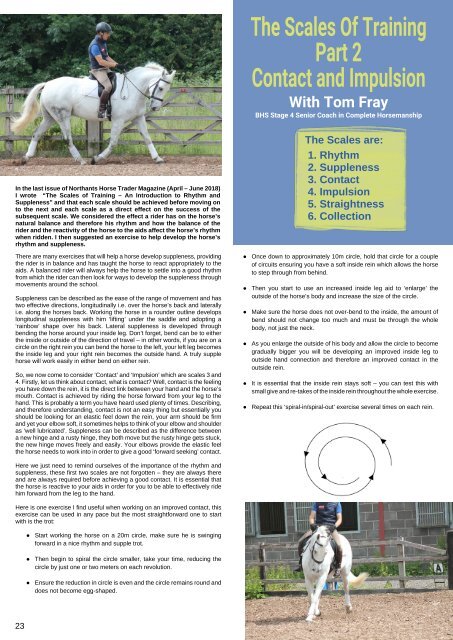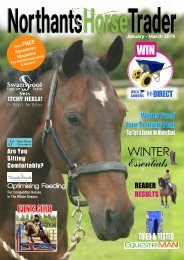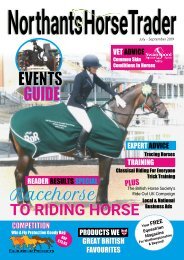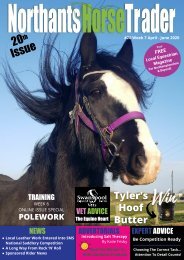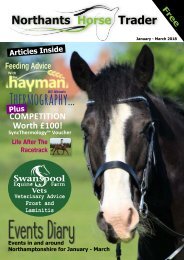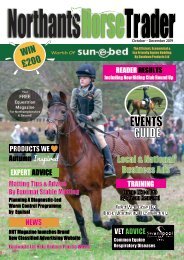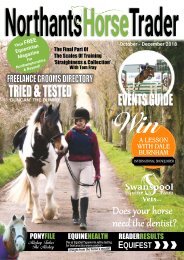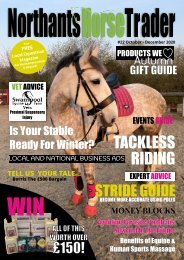NHT Magazine Summer 2018
You also want an ePaper? Increase the reach of your titles
YUMPU automatically turns print PDFs into web optimized ePapers that Google loves.
The Scales Of Training<br />
Part 2<br />
Contact and Impulsion<br />
With Tom Fray<br />
BHS Stage 4 Senior Coach in Complete Horsemanship<br />
In the last issue of Northants Horse Trader <strong>Magazine</strong> (April – June <strong>2018</strong>)<br />
I wrote “The Scales of Training – An Introduction to Rhythm and<br />
Suppleness” and that each scale should be achieved before moving on<br />
to the next and each scale as a direct effect on the success of the<br />
subsequent scale. We considered the effect a rider has on the horse’s<br />
natural balance and therefore his rhythm and how the balance of the<br />
rider and the reactivity of the horse to the aids affect the horse’s rhythm<br />
when ridden. I then suggested an exercise to help develop the horse’s<br />
rhythm and suppleness.<br />
There are many exercises that will help a horse develop suppleness, providing<br />
the rider is in balance and has taught the horse to react appropriately to the<br />
aids. A balanced rider will always help the horse to settle into a good rhythm<br />
from which the rider can then look for ways to develop the suppleness through<br />
movements around the school.<br />
Suppleness can be described as the ease of the range of movement and has<br />
two effective directions, longitudinally i.e. over the horse’s back and laterally<br />
i.e. along the horses back. Working the horse in a rounder outline develops<br />
longitudinal suppleness with him ‘lifting’ under the saddle and adopting a<br />
‘rainbow’ shape over his back. Lateral suppleness is developed through<br />
bending the horse around your inside leg. Don’t forget, bend can be to either<br />
the inside or outside of the direction of travel – in other words, if you are on a<br />
circle on the right rein you can bend the horse to the left, your left leg becomes<br />
the inside leg and your right rein becomes the outside hand. A truly supple<br />
horse will work easily in either bend on either rein.<br />
So, we now come to consider ‘Contact’ and ‘Impulsion’ which are scales 3 and<br />
4. Firstly, let us think about contact, what is contact? Well, contact is the feeling<br />
you have down the rein, it is the direct link between your hand and the horse’s<br />
mouth. Contact is achieved by riding the horse forward from your leg to the<br />
hand. This is probably a term you have heard used plenty of times. Describing,<br />
and therefore understanding, contact is not an easy thing but essentially you<br />
should be looking for an elastic feel down the rein, your arm should be firm<br />
and yet your elbow soft, it sometimes helps to think of your elbow and shoulder<br />
as ‘well lubricated’. Suppleness can be described as the difference between<br />
a new hinge and a rusty hinge, they both move but the rusty hinge gets stuck,<br />
the new hinge moves freely and easily. Your elbows provide the elastic feel<br />
the horse needs to work into in order to give a good ‘forward seeking’ contact.<br />
Here we just need to remind ourselves of the importance of the rhythm and<br />
suppleness, these first two scales are not forgotten – they are always there<br />
and are always required before achieving a good contact. It is essential that<br />
the horse is reactive to your aids in order for you to be able to effectively ride<br />
him forward from the leg to the hand.<br />
Here is one exercise I find useful when working on an improved contact, this<br />
exercise can be used in any pace but the most straightforward one to start<br />
with is the trot:<br />
●<br />
●<br />
●<br />
●<br />
●<br />
●<br />
The Scales are:<br />
1. Rhythm<br />
2. Suppleness<br />
3. Contact<br />
4. Impulsion<br />
5. Straightness<br />
6. Collection<br />
Once down to approximately 10m circle, hold that circle for a couple<br />
of circuits ensuring you have a soft inside rein which allows the horse<br />
to step through from behind.<br />
Then you start to use an increased inside leg aid to ‘enlarge’ the<br />
outside of the horse’s body and increase the size of the circle.<br />
Make sure the horse does not over-bend to the inside, the amount of<br />
bend should not change too much and must be through the whole<br />
body, not just the neck.<br />
As you enlarge the outside of his body and allow the circle to become<br />
gradually bigger you will be developing an improved inside leg to<br />
outside hand connection and therefore an improved contact in the<br />
outside rein.<br />
It is essential that the inside rein stays soft – you can test this with<br />
small give and re-takes of the inside rein throughout the whole exercise.<br />
Repeat this ‘spiral-in/spiral-out’ exercise several times on each rein.<br />
●<br />
●<br />
●<br />
Start working the horse on a 20m circle, make sure he is swinging<br />
forward in a nice rhythm and supple trot.<br />
Then begin to spiral the circle smaller, take your time, reducing the<br />
circle by just one or two meters on each revolution.<br />
Ensure the reduction in circle is even and the circle remains round and<br />
does not become egg-shaped.<br />
23


